Monday, July 31st, 2017
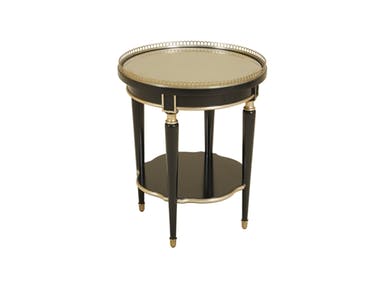
Maitland-Smith Living Room Black Lacquer Finished Occasional Table, Glass Top, Silver Finished Brass Accents 3630-001
Hollywood Regency style also known as Hollywood glam is far from new. In fact, this interior design style began way back in the ‘30s which was known as Hollywood’s Golden Age. Think of gold and glam and opulence and you’re definitely on the right track.
So who are the famous designers who love Hollywood Regency? Elsie de Wolfe, Billy Haines, and Dorothy Draper are the ones who are believed to have catapulted this design to its popularity. Those geometric patterns, black and whites, and color blocks in acid yellow all point to the glamor that is effortlessly achieved in this style.
Emphasis on Glam
When stylizing using Hollywood glam, be sure to put a lot of emphasis on charm and appeal. The furniture pieces for this style leans towards contrasting colors, the richest textures, and the loveliest curves.
You won’t have to doubt whether your home would look lovely because it is sure to become a lot more than this. Instead of the usual low-lying, contemporary pieces that are loved nowadays, what you’ll have is the reliability that luxurious and sumptuous pieces would offer.
Hollywood glam furniture is also about making a bold statement while framing it with delicate accents. You should be able to balance lovely, lavish fabrics as well as luxurious finishes with architectural elements that are traditional.
Bold and Flashy
Though the furniture pieces for Hollywood glam have their fair share of Mid-century modern taste, the rest of the accessories have to be bold and flashy. Search for details that will make you think of Art Deco, jewel tones, and black and white patterns.
White lacquer, as well as gold accents, work pretty well, too. High sheen will always be a part of being flashy and bold. Use lacquer on table tops, mirrors, even mirrored surfaces. Paint floors and use plush area rugs.
Rich colors and strong patterns are crucial features for all Hollywood Regency homes. Even when this is the requirement, these must be used sparingly. To avoid confusion, always keep your décor right on the same palette then just stick to a single or double pattern.
Always focus on the rest of the room through accessories that are light yet cohesive.
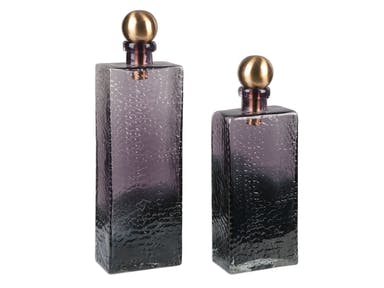
Uttermost Accessories Benedetto Glass Bottles, S/2 20075: Glass and purple for your Hollywood Regency home? Perfect!
Luxe
The most glamorous textures make up every Hollywood Regency habitat. You won’t go wrong with lacquer walls because they are sure to instantly glitz up your room. When you pick fabrics, think of Hollywood movies in the ‘40s and blend them with haute couture gowns. Say yes to chenille, silks, velvet, suede, and fur.
Luxury is also about using anchor colors such as white, black yellow or jolting colors like purple, turquoise, tangerine or fuchsia.
All these lovely textiles offer beautifully distinct finishes. They effectively add depth to your home in such a way that linens and kinds of cotton will not be able to give.
Small Scale Styling Secret
You know how Hollywood can also be the place for cocktail parties and group convos? You don’t have to be bright, golden and bold all the time with this kind of style. In fact, you can begin small.
The classic rule is to use chairs, sofas, and chaises low slung. Their scale must also be modest so they will not overshadow the visitors. Never scatter furniture throughout the room or group them all around your fancy TV. This is simply not Hollywood-ish.
Why Hollywood Regency Works
This larger-than-life style picks from a smorgasbord of interior designs ranging from Neo classical to Chinoiserie to modern and Art Deco. While this is so, you will never feel that the style is a mishmash. It is something that exudes confidence in every layer and impeccable elegance. It is also sophisticated complete with a dash of swagger.
If all these things describe you, then Hollywood Regency style is a great fit.
Tags: Hollywood glam, Hollywood interiors, Hollywood Regency, Hollywood style, McCreerys, McCreerys Home Furnishings
Posted in Interior Design 101, Interior Design Elements, Interior Design Themes | Comments Off on Hollywood Regency: Achieving Celebrity Glam in Your Home
Friday, July 28th, 2017
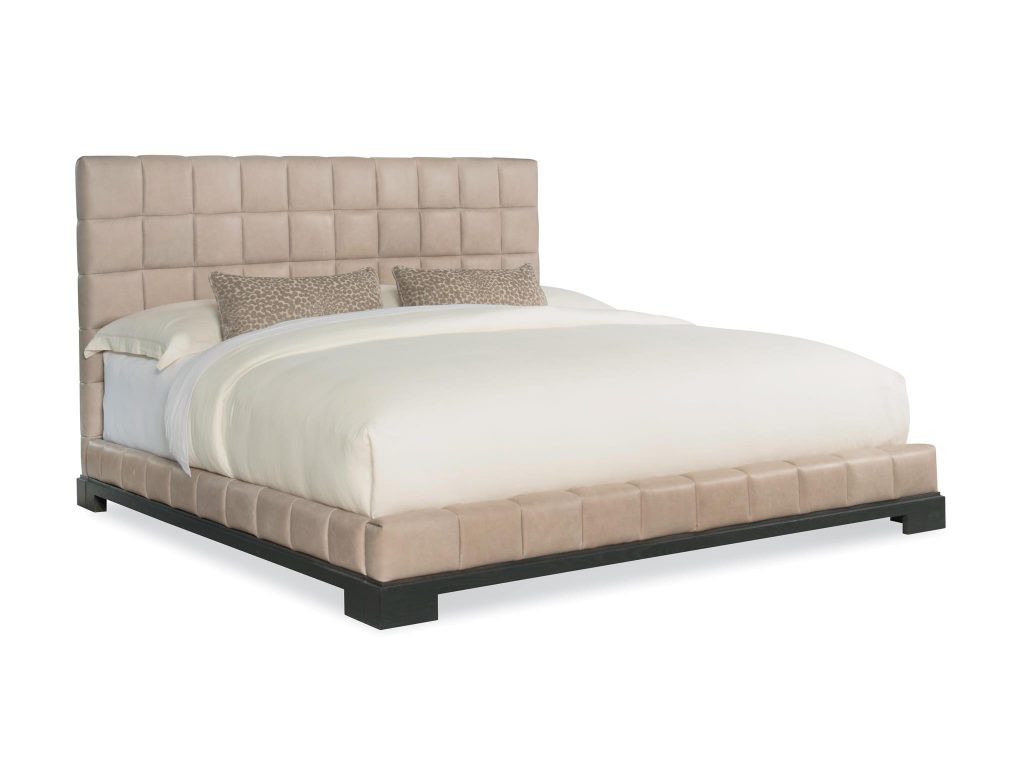
Fine Furniture Design’s Fusion Collection: Orion Upholstered Leather Cal King Bed
The simplest way to define a master bedroom is that it is the biggest bedroom in a house. Designing the layout of the master bedroom is pretty much like setting up a regular bedroom. The easy part is to put in the furniture but you should also consider other factors such as how many would use it, how the bed would be used, where the entry would be situated, and what elements to bring in so that it becomes a restful area.
There are many available resources for the master bedroom furnishing and shopping tips but there aren’t as many historical sources. Now here’s a careful look at the history or evolution of the master bedroom –
Master Bedroom History: In a Nutshell
As early as 77,000 years ago, beds have already been made. Archeologists have unearthed South African beds made from sedge grasses. This bedding was not exclusively made by the South Africans, though.
In the Neolithic period, the Chinese came up with the heating stone on which people could rest at during cold evenings and cooked at during the day. These were used over 7,200 years ago.
The ancient Egyptians were not ones to fall behind. They also used fibers and wood in the creation of furniture pieces and these included beds. Ancient beds made by these people look familiar to modern day men. Egyptian beds were also rectangular and had perforations on their platforms. These perforations were used for ventilation.
By the 16th century, middle-class families began living in their own homes. Some had upper floors but the bedrooms then were sparsely furnished. While this is so, each bedroom already contained the default furnishings – a bed, chest for clothes and a trundle.
The beds and bedrooms evolved throughout the 17th century. The master bedroom began to be similar to the 17th-century beds. Master bedroom interiors could now be traditional or contemporary depending on the style or theme that you chose for your home.
Many homeowners during the 21st century chose to have the aged or vintage appeal for their master bedrooms as opposed to the Industrial Revolution inspired 20th-century designs. Coiled springs became widely available to offer greater comfort. The advent of electricity also welcomed more glitz and glamour inside the bedroom, especially inside the master bedroom.
Now let’s set up your master bedroom –
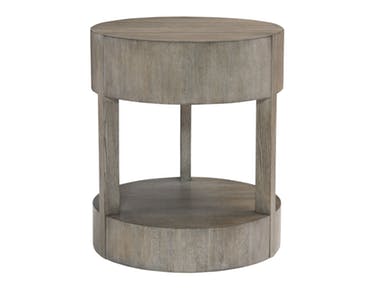
Bernhardt Interiors Bedroom Nightstand 369-212
5 Guidelines in Master Bedroom Setup
First, you need to choose your master bedroom color palette well. Sophistication is certain in neutrals such as taupe, white, gold, charcoal or silver. These are gender neutral colors as well so you won’t have to worry about the room looking too feminine or masculine.
Next, find an oversized linen that’s a size bigger than your bed frame. This is a designer trick that makes the bed look more luxurious.
Third, invest in huge cabinets and drawers. Storage space is a must in every master bedroom. Do not forget to declutter so that you will have more space to use for your clothing and other stuff. If you can, color code all of your clothes, even your shoes, so that you will have an elegant looking master bedroom.
The fourth tip is for you to position the bed correctly. Never, ever put your bed in the corner. This will make climbing in and out of bed a cumbersome experience each time. Also, imagine having to make the bed that’s situated by the corner – now you get the picture.
Be sure to leave at least 24 inches on every side of your bed. This is the minimum measurement required so you can get in and out comfortably.
Just as you’re not supposed to put your bed in a corner, you must also avoid putting your bed at an odd angle. This is a classic space waster.
Lastly, install a side table on both sides of your bed.
Tags: master bedroom, master bedroom design, master bedroom design elements, master bedroom elements, McCreerys, McCreerys Home Furnishings
Posted in Bedroom Design, Interior Design 101, Interior Design Elements | Comments Off on Master Bedroom: The Noteworthy Evolution
Thursday, July 27th, 2017
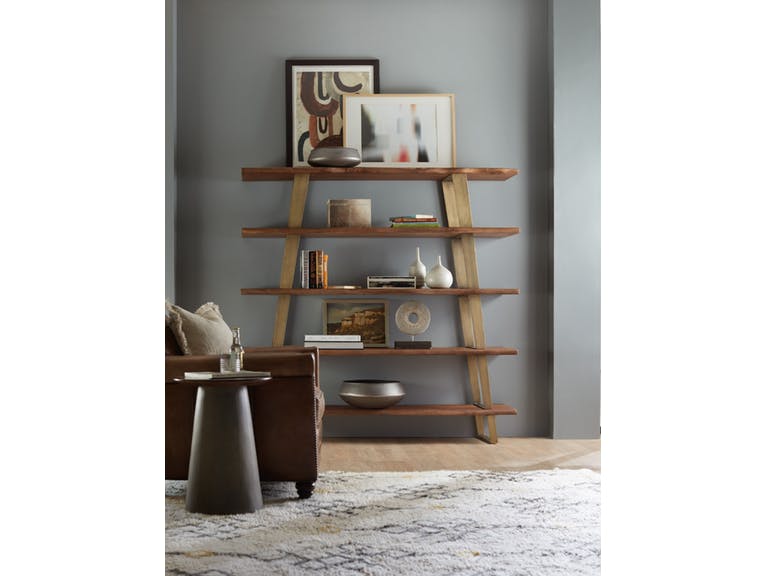
Hooker Furniture Home Office Transcend Bookcase is the perfect example of rectilinear, functional furnishing.
We all live in a modern world. People see contemporary movements in almost every aspect of their daily lives – from fashion, architecture, technology, cars, even the world of interior design. Don’t be confused with the terms contemporary and modern, these are two totally different terms. Modern refers to anything from the 1920s till the 1950s.
Contemporary is anything beyond that though there are designers who look at the ‘70s as the starting line for this type of design. If you want to embrace a contemporary interior design, here are some guidelines –
Openness
Contemporary design, in essence, looks upon some of the major elements of modern design. First, it tends to apply the open space layout. It also nods on wide, open windows as well as high ceilings. As opposed to modern design, though, contemporary elements are focused on the use of natural elements.
Contemporary design is all about airiness. It embraces this aspect of design so that the interiors feel more relaxed rather than stiff.
Broader Hue Options
The color spectrum for contemporary design elements are a lot broader compared to modern design. Black and white is a famous fusion that is commonly used in many modern spaces. To depart from this default modern look, contemporary spaces could use bold patchworks.
Appropriate colors that you can use in your contemporary home are cream, white, brown, grays and beige, which are all neutral tones. Use an accent that is bold enough to counter these neutrals, just make sure that balance is still achieved in the process.
As for the walls, it would also be great to experiment with that. Striped wallpapers are a wonderful idea.
Wooden Floors No Less
Contemporary flooring always has to be wooden. But if you are looking for an excellent substitute, then you can turn to laminates, stone, porcelain, ceramic or cement. Occasional rugs or full carpeting would also make sense in this environment. The colors that you use would have to be neutral or patterned, though.
If you’re still uncertain about what material to use to cover your floor, then just go bare.
Specific Window Treatments
While lighting – especially natural lighting – is crucial in setting up a contemporary setting, there are moments when the light just has to fade or covered. Window treatments for contemporary homes are not limited. You can choose from roller shades in different opacities; shutters which may be traditional in form but they can still look amazing inside contemporary homes; another option is frosted glass which ensures ample lighting while still enjoying a certain level of privacy.
Other options include curtains, Venetian or Roman blinds, and louvers. Louvers are a fusion of Venetian blinds and shutters.
Contemporary Furnishings
Contemporary furniture designers offer a wide array of tables, sofas, chairs, and other home furnishings that would satiate people’s want for current interior design pieces. Anything that was built from the 19th century onwards is considered modern or modern contemporary.
Pieces that have been heavily influenced by the modernist art movement is considered contemporary. Compared to the visual ornate artistry of the periods before modern era, contemporary furniture is all about simplistic visual pieces.
Say no to ornamentation, heavy pieces and stuffiness. Instead, look for rectilinear furnishings that are often lightweight, casual, and therefore, more livable.
Materials used in the creation of contemporary pieces include natural materials, fabrics, and anything that has pronounced lines and edges.
Hidden Technology
Some of the hidden details in a contemporary home include innovative technology such as computers, phones, and smart gadgets fused into homes. Talk of futuristic remote access and wireless equipment put to good use.
Try to bring in more innovative controls inside your contemporary home. These will make your habitat more current and, therefore, more contemporary.
Tags: contemporary, contemporary interior design, contemporary interiors, contemporary style, McCreerys, McCreerys Home Furnishings
Posted in Interior Design 101, Interior Design Elements, Interior Design Themes | Comments Off on Contemporary Is Compelling
Wednesday, July 26th, 2017
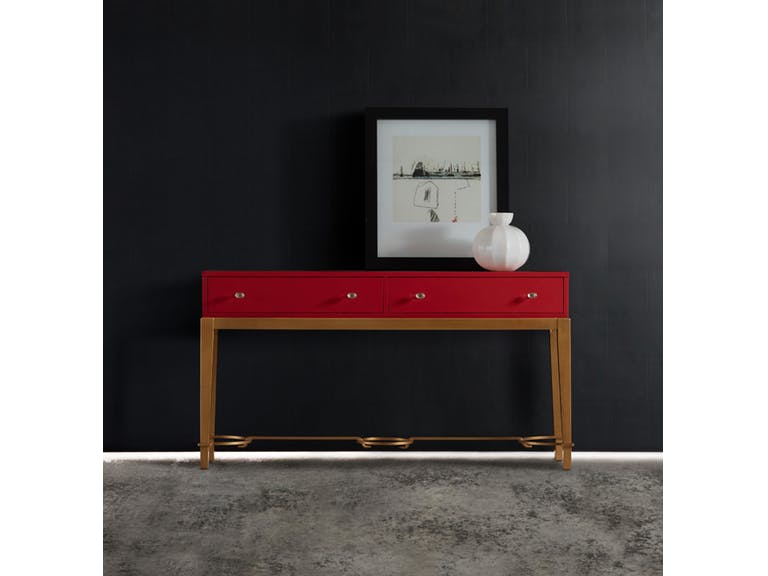
‘Remember the importance of entryway? This Hooker Furniture Living Room Melange Lady in Red Console will surely look perfect in your home.
You have once been a tourist, yes? In those moments when you played tourist for, say, a week or so, which part of the vacation was most restful to you? It wasn’t those moments when you were doing those food trips or the beach or museum visits was it? The most restful were when you went back to your hotel room and laid down to the luxurious Egyptian cotton on your equally luxurious mattress.
This same luxury can also be a part of your everyday life. You don’t’ have to go on a vacay each time just to experience this level of indulgence. It is, after all, worth it to experience such comfort each time that you go home.
There are many ways that you can add a tad of five-star hotel luxury comfort in your home. Here are some –
Begin with the Entry
Wouldn’t it be nice to come home to a display of fresh flowers? These flowers are instant mood-lifters as they add a lovely fragrance and beauty right at the entrance of your home. Those red roses or pink carnations will surely pep everyone up.
Cleanliness Is Close to Godliness
‘Ever wonder why hotels always feel, smell and look fresh? There is this thing called – housekeeping.
Housekeeping is dedicated to cleaning at a totally different level. They treat the hotel customers as guests, hence, they should be treated like royalty.
Here, the linens are sparkling clean, all the solid surfaces have been wiped to shine, and everything else is disinfected.
This doesn’t mean that you would clean your home in this manner. What matters is that the sheets are freshly laundered, the furnishings are clean and highly-maintained, the lighting is perfect, and there is zero clutter elsewhere.
Marbles Are a Must
As are mirrors. Marble just offers the look of luxury without even trying hard. Add some polished brass, gleaming mirrors, and gold-flecked accessories and you have added a touch of luxury.
Try marble on your kitchen countertops as well as your flooring. This is a durable material that is unique because of its design patterns. These have an everlasting appeal that is difficult to match.
The mirrors, on the other hand, widen your space, they can also be used to reflect light so that you get a brighter living space. Mirrors are also necessary inside bathrooms and as a statement piece inside the living room.
Luxury Is Art and Art Is Luxury
Decorative art can easily breathe life into any space. Let your walls serve as a canvas to your lovely pieces of painting and other wall art. The right art pieces can also offer a welcoming ambiance to your home. The right pieces placed at the right places could also define areas.
Art is something that you should not forego if you want to achieve a certain level of luxury. Don’t be intimidated by it no matter how pricey it is. Fresh your family’s black and white photos and these can be instant art pieces, too.
Metals Do the Trick, Too
When thinking of luxury, there must always – always – be a shimmer of metal. The rule to a luxurious space, though, is minimalism. Just add a little pop of metal somewhere so that space is elevated, luxury-wise.
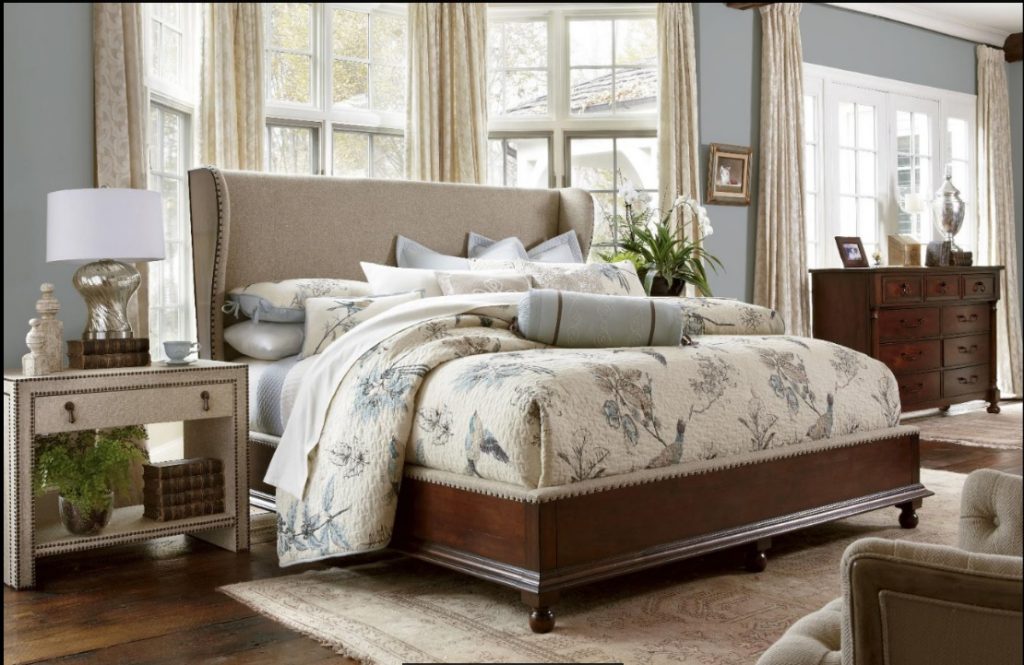
Harbor Springs Upholstered Shelter King Bed is perfect for your luxe-hotel-like bedroom.
Don’t Forget the Bedroom
As you finish donning the rooms with the right lighting fixtures and window treatments it’s time to go to the bedroom to cap your project.
The bed must be the central figure in this ensemble. Match it with the right bedding, curtains, and pillows. The mattress must be supportive and layered with plump down pillows, cotton sheets, and a luxurious comforter.
Now that you’re done, are you ready to enjoy your luxurious home?
Tags: characteristics of luxury homes, designing luxury homes, elements of luxury homes, luxurious home, luxury home, McCreerys, McCreerys Home Furnishings
Posted in Interior Design 101, Interior Design Elements | Comments Off on The Real Meaning of Luxury – 6 Red Hot Tips in Creating the (Seemingly) Million Dollar Home
Tuesday, July 25th, 2017
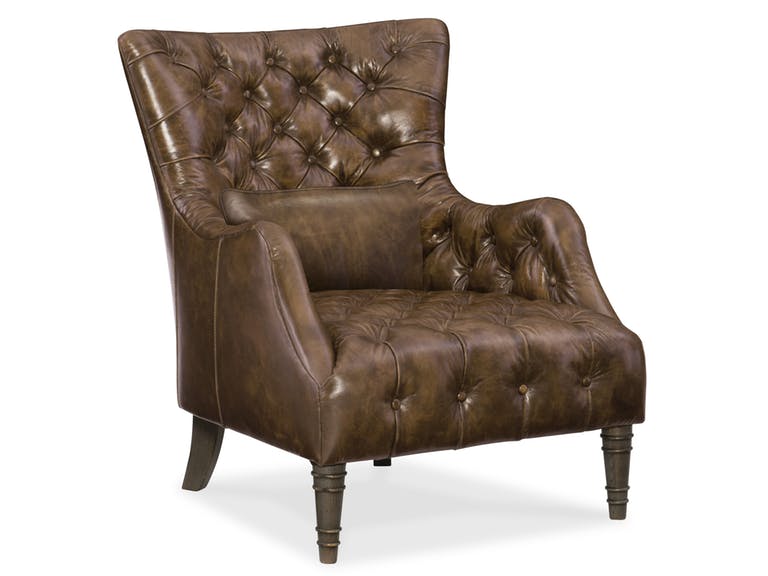
Enjoy your first day in your condo in this Hooker Furniture Living Room Stephanie Club Chair. It’s going to be sublime.
Gleaning condominium design inspirations and ideas is mostly fun, especially now with lots of magazine sites on the Internet. As you take note of the designs that catch your attention, how do you think you could make them happen? Now this is the time when you start feeling overwhelmed.
The chief idea in designing your condo is to break down the project into steps that comprise a system. Here are some tips –
Measurements Matter
Doing this will let you realize how much space you will be working with. Taking the measurements of the living space will help you in your preparation for the next step which is to order the supplies for your interior design project.
Measurements also guarantee that you won’t be ordering too much wallpaper or the wrong size of table for your dining area.
A Single Order Covers All
As soon as you have decided on the paint, fabrics, and furniture, it’s time to order the materials – and all at once as much as possible. Know that there are some materials that take time to arrive so you have to set a head start for these.
Schedule your ordering so that the materials arrive all when you need to begin the project.
Choose a Design Team
Consider all the professionals that you need (e.g. the electrician, painter, upholsterer, etc.). Ask your relatives and friends for some referrals. If you’re not rushing, it is best to interview each professional that you consider for the job.
Begin with the Floor, Up
Would you be sanding or staining your floor? Or would you install wall-to-wall carpeting? Always begin with the floor. This is the best way to avoid damaging or at least minimize the damages to the walls.
Paint
Before you bring in the cabinets and other furnishings, or even before you install all the lighting fixtures, be sure to finish the painting tasks. One of the biggest expenses that you will make will be the preparation and actual painting of the interiors.
Painting may appear to be difficult but with ample preparation (sanding and making sure that the surfaces to be painted are clean), all should be well. If you’re still daunted by the task, then just hire a professional.
Don’t go on default which are white walls and then adding stuff later. Use your favorite color, mix and match.
Hang the Light
After painting, you can now begin to hang the chandeliers, pendants, sconces, or other fixtures. Be sure to install these first before you even display the drapes or any other furnishing so that the fixtures won’t get in the way.
Bring in the Furniture
Ask the help of some of your friends. Bringing in the furniture into your home is one task that you could never do on your own, besides, it would be more fun if everyone had a contribution to the interior design project.
As much as you can, you should have prepared a floor plan as to where each piece of furniture will be placed. Do not be afraid to experiment if the initial plan does not work out.
Accessorize
Lastly, as soon as all the furniture has been placed, it’s time to add the figurines, artworks, lamps, and decorative stuff. Bring in your pillows, books and whatnots. Go ahead, splurge. This is your condo unit after all. These small items will surely add touches of who you are – and this is something that you would want everyone to know.
Add all the pretty details now, emphasize all the stunning views (e.g. the window opening towards the skyline during the evening), or shine the lights towards the crown molding.
Once you’re done with these steps, sit down and enjoy what you’ve accomplished.
Tags: condo designs, designing a condo, McCreerys, McCreerys Home Furnishings, stylizing condos
Posted in Apartment Living, Condo Living, Interior Design 101, Interior Design Elements | Comments Off on Condo Fit Living and Furnishing
Monday, July 24th, 2017
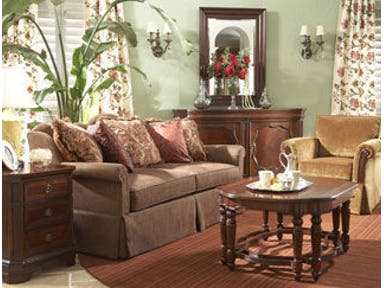
Fine Furniture Design Living Room Side Table 920-960
Interior design, when spoken of as a profession, is relatively new yet it’s constantly evolving. To be involved in this industry, one needs education, ample experience and in some states, it is even necessary to take a licensure exam. The function as well as the quality of interiors, after all, depend on interior design.
On the so-called journey of the interior design process, designers often times define what they do as well as what they work with. To some, good design means the fusion of function and beauty. Others view it as having an efficient and durable home. Still, others see interior design as an expression of one’s self onto his home or workplace.
Interior design may also be viewed as a series of choices and their consequences. Lastly, it should be holistic.
To know whether interior design is art or science, let’s take a look at the principles that comprise this term –
Principle of Unity
Interior design asks for a sense of uniformity and harmony. This should be your visual guide in understanding your living space. Minus unity, the homeowner will simply get confused.
All the design elements that were used must complement each other and the visual transition must be hard to miss. As a designer, you need to learn to overlap the elements so that they work together instead of competing with one another.
Principle of Balance
This is the orderly distribution of elements. Visual equilibrium is achieved through this principle.
There are three ways to achieve balance in interior design – through symmetrical, asymmetrical and radial ways. Symmetrical balance has a central axis where both halves are provided with equal design elements. Asymmetrical, on the other hand, keeps an odd number of design elements though there still is an imaginary central axis (a.k.a. the focal point). Radial, simply put, uses circular symmetry (e.g. chandelier hanging in the middle of a dining room).
Principle of Rhythm
This suggests the linked movements between all the design elements. This is essential so that a visual tempo is maintained. Elements must be repeated throughout the space in an orderly manner. There are three methods in achieving rhythm – repetition, progression, and alternation.
Principle of Emphasis
As the term suggests, this principle centers on having a focal point. This could be color, texture, pattern or a piece of furnishing. To use effectively, make sure that the focal point is the most dominant piece in a space.
Principle of Contrast
Contrast is the difference between color, luminance, form or space. An awesome example of this is when you use black and white in a home. This is also the principle that’s being followed when a circular mirror is paired with a rectangular sofa.
Principles of Scale and Proportion
These ensure that all the design elements placed inside a living space belong to one another. This can be determined by the objects’ shape, size, color or even dimensions. An example is when you have a high ceiling; this means that you have to look for bigger or taller furniture instead of the low rise pieces in the market.
Principle of Details
These are the capstones of an interior design. This could be the embroidered design on your colored throw pillows inside the living room. This could also be the ornate designs on the legs of your antebellum furnishings.
Details could be patterns or textures. They can be repetitive or not.
Conclusion
Now that you learned the different principles of interior design, what do you think it is? Is it science, art, or both? To the trained eye and those that have a creative instinct, it is both and so many other things.
Tags: interior design principles, McCreerys, McCreerys Home Furnishings, principles of interior design
Posted in Interior Design 101, Interior Design Elements | Comments Off on Interior Design – Art or Science?
Friday, July 21st, 2017
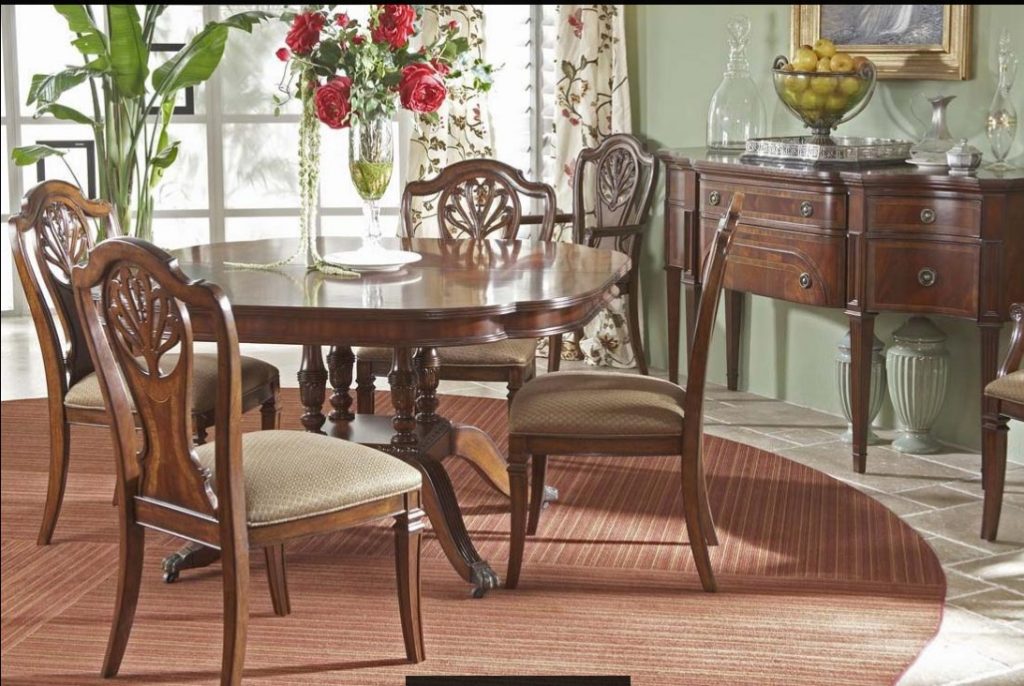
‘Notice the contrast of this Antebellum collection against the tamer backdrop?
There are many principles to talk about when discussing interior design. But when organizing and designing, it is a wonderful tool that you can use effectively. But, first, let’s define color contrast.
If you are to define contrast in interior design, this is the difference between two hues – that is all there is to it. When you’re building a webpage, though, it becomes an entirely different thing. You would want to have a high contrast between the background color and the text. High contrast between interior design elements could give a messy look. Yet black and white is the highest contrast that can be created.
Contrasting Colors
Colors may contrast in value, hue and saturation yet color theorists have come up with different kinds of contrasts through the years.
Hue contrast is as simple as saying high contrast or low contrast. This relates directly to the fusions on the color wheel. The farther each color is from each other, the higher their contrast becomes. Complementary colors have the highest contrast while the opposite is true with analogous color combinations.
A special contrast of hue is the so-called cool and warm colors. These depend much on how the eyes work. Warm colors appear closer while the cooler ones are more distant.
Contrast of value is best in the creation of bigger contrasts. Black and white is believed to be the highest contrast of value. Huge differences in lightness are pleasant to the human eye. Lower contrasts on value can be used on subtle differences.
Saturation contrast is best used in designing aspects that don’t require emphasis. Color sets with varying saturation that are set against a gray background, for instance, is seen as transparency. This is an interesting piece of design aspect.
Decide which part of your home you would like the color contrasts to take place. Imagine a pastel sofa surrounded by other pieces of furniture in jewel tones. These will make for a wonderful rendition of successful color combination.
You could be tempted to keep the walls white but try saffron instead. When combined with green tiles, the saffron wall would create a more interesting visual thing to look at.
Blue and reds, grays, oranges, greens and yellows can be combined as warm and cool tones. They can be used to balance the ambiance, to make cozy, or to create drama.
Contrast in Composition
When talking about color contrast, this generally refers to a number of color fusions yet it is not limited to these. Textures can also be contrasted with the right set of hands. Shapes can, too, though this is rarely done. If you want to start using shape contrasts at home, then you can look for geometric or boxier pieces and start mixing them with round or curvy pieces of furnishings.
Going back to colors, you can also add a pop of color to any colorless space so you can perk it up or give it a more interesting dimension.
Dark blue walls and turquoise blue may be close on the color scale but they can still appear different. These colors just prove that even almost similar colors can be perceived differently. This example of color combo can also be used as an exciting pop of color in a room where you would want some activity and increased productivity.
Juxtaposition is also about experimenting with visual interest. This means being comfortable in mixing lighter oak with walnut or granite countertops with walnut cabinets.
A Contrast Room?
When you want a bright, white home, having a dark more mysterious room might be a far out idea. Not in a home where contrast is being set up. How about having the guest room in dark color while the rest of your home swims in a lighter hue?
Tags: contrast, contrast in interior design, interior design contrasts, McCreerys, McCreerys Home Furnishings
Posted in Interior Design 101 | Comments Off on Interior Design Contrasts: Using Juxtaposition to Your Advantage
Wednesday, July 19th, 2017
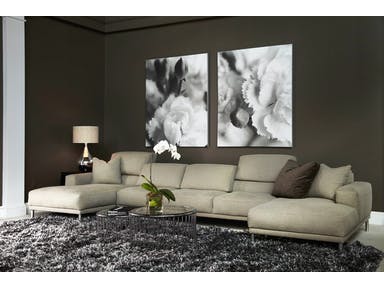
The bare essentials are covered in this ensemble – from the American Leather Living Room Meyer sectional to the basic table lamp, rug and the monochrome art on the wall.
Living a minimalist lifestyle is definitely not for everyone. In a busy world such as ours, a lot of people feel that need to have less as they become more and more busy. But where should you begin when you are serious about living a minimalist life?
A Beginner’s Path
You probably heard of those people who have taken the leap and have finally decided to embrace minimalism. These people agreed to spend less and even to have less. They end up needing less and living simpler lives.
The minimalist’s timeline must always be set. It is also important to define what is minimal for you. As you see, what’s minimalist for your sibling may not be exactly true with you. If there is one thing that is common among those who say yes to minimalism, it would have to be decluttering.
A whole house that was once filled with stuff can be turned into a minimalist home by removing the things that cause stress to its inhabitants. Focus on the things that you want and keep only the objects that you need.
Decluttering is one of the most painful steps in becoming a minimalist. Begin with a clear intention even if you have to progress slowly. As you slowly declutter, throw or donate the rest of your stuff which you no longer need.
This might take a few weeks or even a few months. Give it time. Forcing the whole thing might have you
Minimalism is all about doing what you are passionate about and what keeps you alive. You then begin to strip away your schedule, your home and your lifestyle of all the things that do not really matter to you.
Have a definite goal as to when you will be able to attain your minimalist home and lifestyle. You also need to define the steps towards becoming a minimalist. If you have to, create some alerts on your calendar so that you will be reminded of your goals.
Next, you have to decide now. Stop putting off your minimalist goals. You could keep your current home or, who knows, you might even go for a simplified or a much smaller home.
This is a huge step for people who are used to renting or already own big homes.
Minimalist living could also mean traveling and living off of what’s inside your backpack. This is a little extreme, though. You can just begin with having a minimalist interior design for now.
Living with less means stripping yourself of some of the comforts of life. Do this, again, ever slowly so that you won’t have cold feet in letting go of luxuries in life. The golden question to ask is always this – do I really need this?
Reusing stuff is also a good way to live a minimalist life. Repair your clothes instead of buying new ones, cook leftovers, and think before swiping your credit cards.
The Modern Minimalist Home
When it comes to interior design, be sure to invest in high quality furnishings. This is the great secret. You could have a home filled with dreamy pieces but you have to be able to recognize which you just like and which ones you absolutely need and adore.
Characteristics of a minimalist home include having just the functional yet still decorative pieces. The number of furniture, though few, ascertains that the room still feels cozy not empty.
Minimalism could also mean having blank or bare walls. Don’t hang a lot of pictures or paintings as these will only make the place look cluttered.
Clear the floors, too. Nothing should be seen there. As to the colors in your home, keep them to a bare minimum, too. Think of pastels, beige and other neutral colors.
Tags: McCreerys, McCreerys Home Furnishings, minimalism, minimalist design, minimalist interiors, minimalist living
Posted in Interior Design 101, Interior Design Themes | Comments Off on Bare Essentials: Minimalism as a Lifestyle
Tuesday, July 18th, 2017
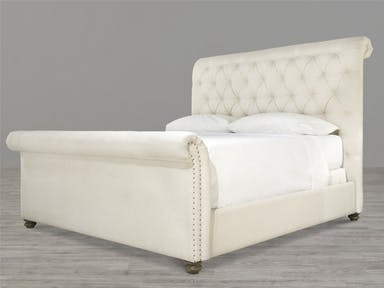
Universal Furniture Bedroom The Boho Chic Bed Rails 6_0 45077R
During the first few years of the new millennium, more specifically during the 1990s, it was observed that ethnic style took center stage. This style got its influence from fashion designers, the likes of Dries van Noten, Kenzo, Christian Lacroix, Vivienne Tam, to name a few. These designers, in turn, were inspired by a variety of styles namely African, Asian, Arctic, and Native American. They were not afraid to use unique styles from far away lands.
Ethnic fashion also found sources of its own inside the Western hemisphere. Northern and Eastern European nations also gave their own share of the ethnic style.
Ethnic Aesthetics
For a lot of Western designers, Eastern aesthetics have become a rich source of subjects. Their creativity was easily spurred by the colorful cultures that reside within the Eastern hemisphere. Here, breaking conventions is perceived as a way of finally seeing or being freed from something that has kept one shackled.
Simply defined, ethnic fashion is eclectic and eclectic fashion is ethnic. This is also applicable to interior design.
Exoticism is more often associated with the faraway nations and is, therefore, broader than the common eclectic term. Here, you are rerouted from being a Westerner to being appreciative of other cultures.
Ethnic Design – The Beginning
Back in the day, luxury is linked with anything that’s foreign. Since this is so, it becomes difficult to actually trace where and when ethnic design was born in the West. One has to take into consideration the trade routes that passed through the West which include Egypt, Persia, and Central Asia. Later, other nations were added to these including China, India, Japan, Mexico, Colombia and many more.
French and Italian silk productions were soon founded, still catering for much more demand for ethnic look.
By the 1800s, cashmere and silk became quite popular and fully used in many aspects of fashion.
Diverse Style
Ethnic style is crucial in fashion though somewhat ignored. As the world of fashion moves ever forward to adjust to the existence of diverse cultures, naturally, interior design follows suit. With these culturally diverse styles, we can now have a clearer definition of what ethnic interior design is all about.
There are various types of designs for ethnic styles depending on who is using them and what ideas are being utilized. All people have a rough idea on what their ultimate dream house would actually look like. Some homeowners opt for a Western style while others prefer the unique ethnic features that Eastern designs offer.
In essence, Chinese or Japanese interior design can be considered ethnic, as are Indian, Filipino or Thai interiors.
The Ethnic Bedroom
It is always safest to begin with the bedroom when it comes to designing projects. Find out what kind of ethnic bed you would want and what materials will be used – gold metal? How about wicker? Or bamboo perhaps?
The shape, patterns, and colors will also define if you are embracing an ethnic interior design. Japanese style beds would have you sleeping closer to the floor or on the floor. Chinese beds have hints or splashes of gold. The choices are almost limitless.
As to window treatments, there is also a huge difference between the blinds that you could use with Japanese interiors and the heavy drapes that often decorate Chinese bedrooms.
When specifically embracing the Boho style or the Bohemian look or Boho-Chic, think of the hippie or gypsy fashion statements. Who you are pretty much dictates what your home’s design elements would contain.
So, will ethnic style suit you well? Also, consider if your family members are also amenable to this style. Once you have come to a concession, then go ahead and alter the style of your habitat.
Tags: Boho, Boho-Chic, Boho-ethnic, ethnic interior design, ethnic interiors, ethnic style, McCreerys, McCreerys Home Furnishings
Posted in Interior Design 101, Interior Design Themes | Comments Off on Recognizing the Boho-Ethnic Look
© McCreery's Home Furnishings | All Rights Reserved | Privacy Policy